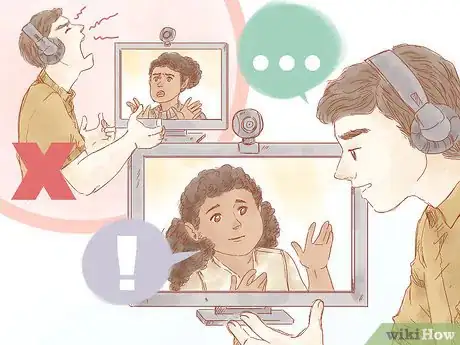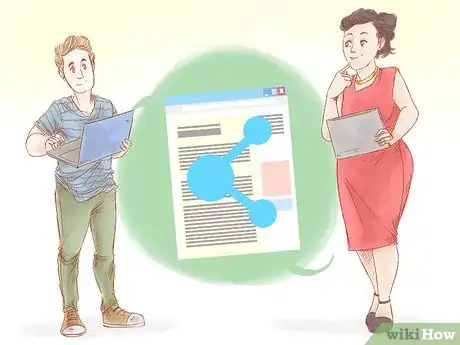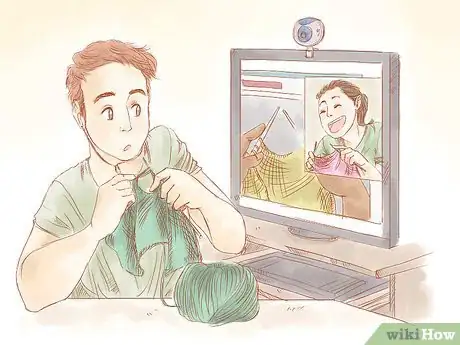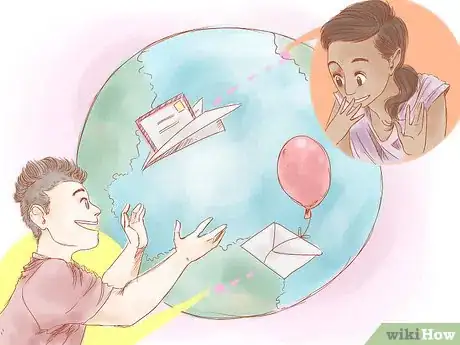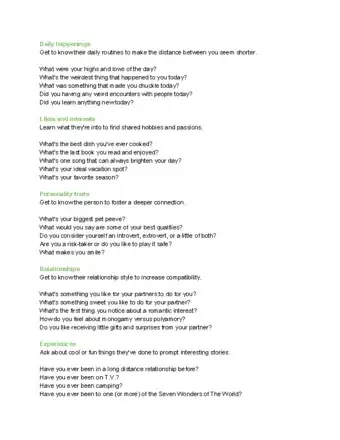This article was co-authored by John Keegan. John Keegan is a dating coach and motivational speaker based in New York City. He runs The Awakened Lifestyle, where he uses his expertise in dating, attraction, and social dynamics to help people find love. He teaches and holds dating workshops internationally, from Los Angeles to London and from Rio de Janeiro to Prague. His work has been featured in the New York Times, Humans of New York, and Men's Health.
There are 10 references cited in this article, which can be found at the bottom of the page.
wikiHow marks an article as reader-approved once it receives enough positive feedback. This article received 21 testimonials and 81% of readers who voted found it helpful, earning it our reader-approved status.
This article has been viewed 9,000,166 times.
No one's ever said that long distance relationships are easy, but the distance doesn't have to ruin your relationship either. With the right commitment and communication, long distance relationships can actually be more stable than geographically close relationships.[1] Simple adjustments to your attitude and lifestyle can help you keep your loved one in your life.
Steps
Preserving Normality When You Can
-
1Stay in contact. Since you won't be seeing each other in person, it's important to establish and maintain an emotional connection as often as you can. Having a lot of long, in-depth conversations is common for a long-distance relationships, and this is one of their positive sides. However, your talks don't always have to be like this.[3] Frequent communication, no matter how minor, will show that you care enough to put in the time and effort into the relationship[4] and it’s easier to keep up to date with each other’s lives.[5] If you allow large (days at a time) gaps to pass by, your everyday experiences fade into the background, and you will have to start from scratch every time you speak.
- Learn your partner's preferred method for communication. Be sure to try a variety of technologies to see what works best for you both.[6] You may try texting, emailing, or video-calling to keep up to date with little daily details of your lives.
- Work around your schedules. If you know you're going to be too busy to communicate, let your partner know in advance and try to stay in contact as best you can. If you're not as busy as your partner, remain flexible and focus on something of interest to you.
-
2Talk about the mundane, little things. Don't feel as though every conversation needs to be a thoughtful discussion about your relationship, hopes, or dreams. Instead, focus on the little things that couples who live together would, such as grocery shopping, doing chores around the house, or redecorating.[7] This gives the feeling of creating a home together, something you both can look forward to.
- Talking about the boring or mundane parts of your day can also foster connection and interdependence, the foundation of relationships.[8]
- Share other small things during the day. You can send your partner a song and tell them that it reminds you of them, or you can share a YouTube clip that you are watching.
Advertisement -
3Visit often. Try to make the time to visit each other as often as possible or as often as your budget permits. You need to see each other in person at every opportunity.[10] [11] Make a regular visiting schedule or at least make plans for the next visit as soon as each one ends. Face-to-face communication is just as important as having relationship satisfaction, commitment, and trust.[12]
- Create your own rituals around your visits, like eating at a favorite restaurant, enjoying a quiet night together at home, or sharing a favorite activity.
- Smooth out travel logistics so they don't get in the way of your time together. Know where to meet at the airport or train station. Learn to travel with one bag or leave basics at your partner's home to save time at the airport.
- Meet away from home sometimes, too. Visit a place together that is new to both of you or choose a place that is halfway between both of you.
-
4Get to know each other. Just like any relationship, you should spend some time really getting to know and understand your partner. When talking, take note of things your partner enjoys the most (like hobbies or day-to-day activities) and do a little research on it so you have something more to discuss.
- Knowing each other's preferences will also help when you want to exchange gifts. Gift exchange is just another way to communicate your feelings for each other over the long distance.[13]
-
5Remember that your partner is human. Distance makes the heart grow fonder, but can also make you idealize your partner. While this can make your relationship stable, extreme idealization (thinking your partner is perfect) will make it more difficult to reunite with the actual person.[14]
- Maintaining day-to-day communication about your everyday lives will help humanize your partner and become aware of changes your partner might be going through.[15]
-
6Support each other, even over the distance. Be there for your partner if your partner is ever in trouble, hurt, or for whatever reason. You need to make yourself available to help so your partner knows you care. If your partner ends up dealing with important issues alone, your partner will eventually not need you.[16] Interdependence refers to the willingness to act against your own self-interest for the benefit of you partner or for your relationship.[17] Instead, supporting each other creates an interdependence that is crucial for a long distance relationship.
- Interdependence can be seen in everyday activities like compromising about decisions and long-term behaviors like quitting smoking.
-
7Create trust. Trust in a relationship is vital, regardless of distance.[18] Try your best to be faithful and avoid temptation. If you do make a mistake, it’s especially important to be honest and tell your partner the truth in cases where lying would benefit you.[19] For example, if you put yourself in a position of temptation (like going to a bar), lying about your whereabouts would benefit you personally, but would benefit your relationship if you were honest.
- Jealousy is harmful for your relationship. If you smother the person, expecting them to answer immediately every time, or if you spend your time wondering where they go and with whom, it won't do you any good.
- Frequent use of email and online resources can help cultivate trust in romantic relationships.[21] [22]
-
8Be committed to each other. Be open and honest by volunteering private information.[23] You should both be morally committed to each other, continuing the relationship because of personal values, not because of social pressures.[24] Personal values include beliefs like “staying faithful is part of my identity.” Social pressures involve the perception of society's approval or disapproval. For example, “My mom would be devastated if I cheated on my girlfriend and she broke up with me.”
- Watch out for behaviors where your partner tries to manipulate you into doing something that only benefits your partner, like lying about an emergency to get you to answer your phone during an important business meeting. If dishonesty and manipulation become a part of your communication, then you must revisit why your relationship lacks trust.
-
9Don't do anything irrational just because you're angry or upset about something they've said or done. Communication is key, if you have a problem then talk it out, it will build better trust and a stronger bond. You can't maintain a relationship if you are terrified that they will do something to you because you did something out of anger.
Doing Things Together and Bonding
-
1Share something. Create something that you both can access and share, such as an online blog or scrapbook. This will give you a new way to communicate while also giving you the sense of creating something together.[25] You might create a food blog with your culinary adventures, Instagram your workouts, or create a special Twitter hashtag just for you two.
- Share your online calendars too. If you miss each other, you'll have someplace to look to see why. You'll also have something to talk about, as in "How was the concert last night?"
- Get involved in each other's professional life. For example, if you are working on a work project, ask your partner what they think of it and whether they have any suggestions.
- If you are in school, ask them to go through your paper with you.
-
2Do the same things at the same time. This will make the distance between you seem smaller and more bridgeable.[28] You'll feel closer together and you'll be bonding at the same time. If you're unsure of things to do, try one of the following:
- Plan to cook the same meal on the same day. If neither of you are into cooking, you might just plan to eat the same cuisine or snack.
- Read the same book or article. You can even take turns reading it aloud to each other.
- Watch a TV show or movie simultaneously. Keep a call open and share your reactions.
- Use video phones to chat while having meals or watching movies together.
- Sleep together. You can both get on the phone or video chat and fall asleep together. Doing this occasionally can make you feel closer. If time zones are too different, try instead to be online to say good morning or good night to your partner.
-
3Learn together. Choose a project you'd both like to do, like take an online language class or learn how to knit. Do whatever you're both interested in. This will give you a wonderful sense of shared history and you'll have something that really ties you together. It's also a great way to spend time together while giving you something to talk about.
- Take advantage of the internet. You could play an online multiplayer game or something traditional, like chess. Either way, you can chat while playing, giving you a greater feeling of togetherness.
-
4Make each other feel special. Try to do little things that let the other person know that you care. You may write love letters and send them in the mail. Or, send small gifts, cards, or flowers for no reason.[30] It's easier than ever to find ways to send almost anything to your partner.
- Don't feel as though you can send something that makes a grand gesture. The little, frequent things are just as important as making the person feel special on special occasions.
-
5Pursue common interests. Try new things together, even if it means doing them apart. This way, you're not just talking on the phone, which can be a pitfall of long-distance relationships if it's the only thing you ever do. Instead, do something romantic like stargazing while you're on the phone. Synchronize and set your watches to go off at the same time every day, and make it a point to think of each other when your watch goes off.
- Remind yourself that your partner is thinking of you while you do these activities together, even though you're far apart. It can strengthen your bond.
-
6Create connections. It's important to feel like you have a place in your partner's life. Try meeting one another's friends, online or off.[31] This will help you understand more of your partner's life and make communication easier.
- If one of you must someday move so that you can be together, that person will be leaving friends behind. Start right away to begin a new social and professional network for the partner who is moving.
Setting Expectations and Boundaries
-
1Discuss the nature of your relationship. Ask the important questions right away to make sure you are both clear on the nature of the relationship. Decide what kind of relationship you both want. For example, are you dating, seeing each other, boyfriend-girlfriend, or engaged? You should also define the exclusivity of the relationship (whether you'll see other people). For example, you might ask, "Are you open to relocating if the relationship becomes more serious?" or "What are you looking to get out of this relationship?"
- While these can be hard questions to ask and might lead to difficult conversations, defining the relationship will save you great heartache and misunderstanding later. This is important to build the relationship you both want.
-
2Talk through doubts, uncertainty, and fear together. Explore the scary and difficult subjects along with the good. Consider this as a chance to explore your feelings together honestly. Recognizing your partner’s ups and downs while you are physically apart will make you more accepting and comfortable with their low points when you see each other in person.
- It's understandable that you might only want to focus on the positive. But, you should let your partner know your low points.[32] Both of you are human, and it’s ok to not always be happy.
-
3Remain positive. Focus on the positives of the distance, such as the ability to pursue your interests, hobbies, and career objectives. Realize that the distance will also push both of you to be more creative when it comes to communicating and expressing your feelings. Look at this as a chance to test your communication skills and emotions.
- In a long-distance relationship, it is important to know that you are building something together, and that there is something in the future for you.
- As long as you see the long-distance relationship as a temporary state, you will keep your chin up and send that feeling of security and happiness to your partner too.
-
4Have reasonable expectations. Remember, every kind of relationship takes hard work and dedication to your loved one or partner, whether it's long distance or nearby. If you and your partner are willing to take these steps, then expect bumps and turns in the road. If you can learn to navigate them, these challenges will only contribute towards a better relationship in the long term.
- For example, you may be prepared to have difficulties around important dates or holidays that you must be apart for. If you know you can't be together for your anniversary, try to plan some special way to connect anyway.
Conversation Help
References
- ↑ Stafford, L., & Merolla, A. J. (2007). Idealization, reunions, and stability in long-distance dating relationships. Journal of Social and Personal Relationships,24(1), 37-54.
- ↑ Aylor, B. A. (2003). Maintaining long-distance relationships. Maintaining relationships through communication: Relational, contextual, and cultural variations, 127-140.
- ↑ Aylor, B. A. (2003). Maintaining long-distance relationships. Maintaining relationships through communication: Relational, contextual, and cultural variations, 127-140.
- ↑ Johnson, A. J., Haigh, M. M., Becker, J. A., Craig, E. A., & Wigley, S. (2008).College Students’ Use of Relational Management Strategies in Email in Long‐Distance and Geographically Close Relationships. Journal of Computer-Mediated Communication, 13(2), 381-404.
- ↑ Aylor, B. A. (2003). Maintaining long-distance relationships. Maintaining relationships through communication: Relational, contextual, and cultural variations, 127-140.
- ↑ Johnson, A. J., Haigh, M. M., Becker, J. A., Craig, E. A., & Wigley, S. (2008).College Students’ Use of Relational Management Strategies in Email in Long‐Distance and Geographically Close Relationships. Journal of Computer-Mediated Communication, 13(2), 381-404.
- ↑ Sahlstein, E. M. (2006). Making plans: Praxis strategies for negotiating uncertainty–certainty in long-distance relationships. Western Journal of Communication, 70(2), 147-165.
- ↑ Stafford, L., & Merolla, A. J. (2007). Idealization, reunions, and stability in long-distance dating relationships. Journal of Social and Personal Relationships,24(1), 37-54.
- ↑ Dainton, M., & Aylor, B. (2002). Patterns of communication channel use in the maintenance of long‐distance relationships. Communication Research Reports,19(2), 118-129.
- ↑ Aylor, B. A. (2003). Maintaining long-distance relationships. Maintaining relationships through communication: Relational, contextual, and cultural variations, 127-140.
- ↑ Aylor, B. A. (2003). Maintaining long-distance relationships. Maintaining relationships through communication: Relational, contextual, and cultural variations, 127-140.
- ↑ Stafford, L., & Merolla, A. J. (2007). Idealization, reunions, and stability in long-distance dating relationships. Journal of Social and Personal Relationships,24(1), 37-54.
- ↑ Aylor, B. A. (2003). Maintaining long-distance relationships. Maintaining relationships through communication: Relational, contextual, and cultural variations, 127-140.
- ↑ Stafford, L., & Merolla, A. J. (2007). Idealization, reunions, and stability in long-distance dating relationships. Journal of Social and Personal Relationships,24(1), 37-54.
- ↑ Finkel, E. J., & Campbell, W. K. (2001). Self-control and accommodation in close relationships: an interdependence analysis. Journal of personality and social psychology, 81(2), 263.
- ↑ Simpson, J. A. (2007). Psychological foundations of trust. Current directions in psychological science, 16(5), 264-268.
- ↑ Simpson, J. A. (2007). Psychological foundations of trust. Current directions in psychological science, 16(5), 264-268.
- ↑ Dainton, M., & Aylor, B. (2002). Patterns of communication channel use in the maintenance of long‐distance relationships. Communication Research Reports,19(2), 118-129.
- ↑ Johnson, A. J., Haigh, M. M., Becker, J. A., Craig, E. A., & Wigley, S. (2008). College Students’ Use of Relational Management Strategies in Email in Long‐Distance and Geographically Close Relationships. Journal of Computer‐Mediated Communication, 13(2), 381-404.
- ↑ Petronio, S. (2013). Brief status report on communication privacy management theory. Journal of Family Communication, 13(1), 6-14.
- ↑ Lydon, J., Pierce, T., & O'Regan, S. (1997). Coping with moral commitment to long-distance dating relationships. Journal of Personality and Social Psychology, 73(1), 104.
- ↑ Aylor, B. A. (2003). Maintaining long-distance relationships. Maintaining relationships through communication: Relational, contextual, and cultural variations, 127-140.
- ↑ Stafford, L., & Merolla, A. J. (2007). Idealization, reunions, and stability in long-distance dating relationships. Journal of Social and Personal Relationships,24(1), 37-54.
- ↑ Aylor, B. A. (2003). Maintaining long-distance relationships. Maintaining relationships through communication: Relational, contextual, and cultural variations, 127-140.
- ↑ Sahlstein, E. M. (2006). Making plans: Praxis strategies for negotiating uncertainty–certainty in long-distance relationships. Western Journal of Communication, 70(2), 147-165.
- ↑ Stafford, L., & Merolla, A. J. (2007). Idealization, reunions, and stability in long-distance dating relationships. Journal of Social and Personal Relationships,24(1), 37-54.
About This Article
To make a long-distance relationship work, stay in contact with your partner as much as you can, whether you're texting, chatting on the phone, or video calling each other, so you're up to date on each other's lives. You should also try to establish a regular visiting schedule so you have something to look forward to when you're missing each other. Additionally, keep in mind that just because you're long distance doesn't mean you can't do things together. For example, you can watch the same movie while video chatting or cook dinner together over the phone. For more advice from our Counselor co-author, like how to build trust in a long-distance relationship, read on!








